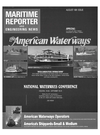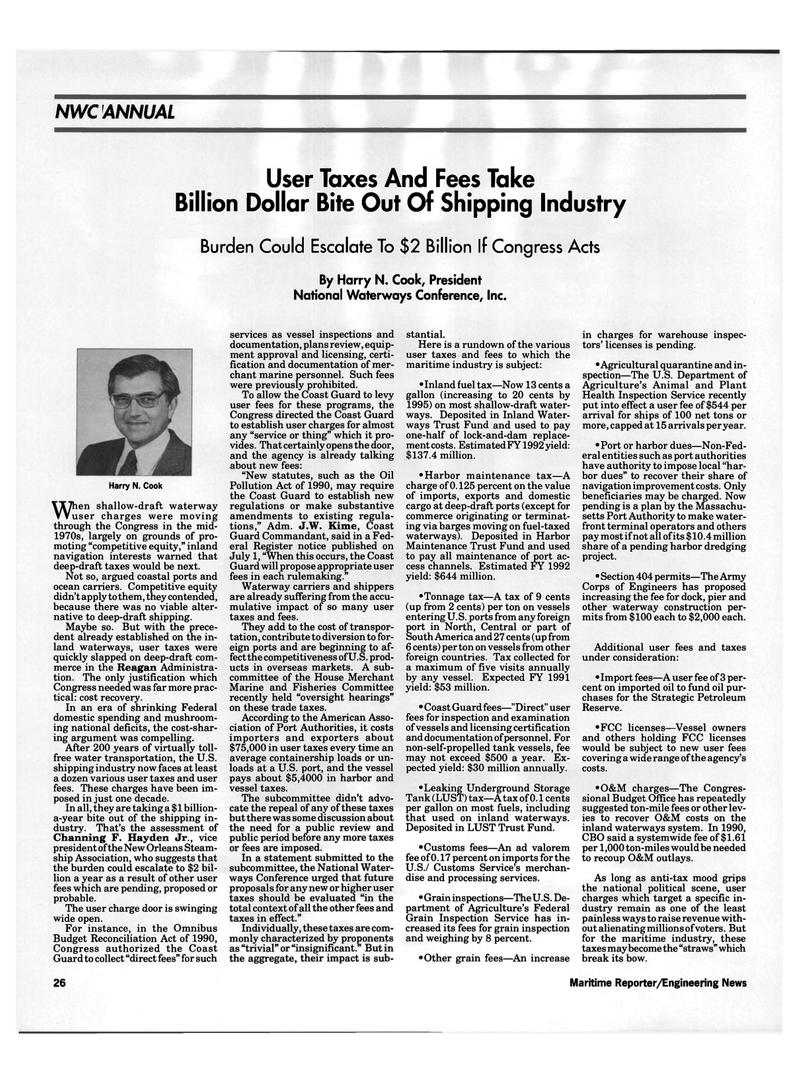
Page 24: of Maritime Reporter Magazine (August 1991)
Read this page in Pdf, Flash or Html5 edition of August 1991 Maritime Reporter Magazine
NWC ANNUAL
User Taxes And Fees Take
Billion Dollar Bite Out Of Shipping Industry
Burden Could Escalate To $2 Billion If Congress Acts
By Harry N. Cook, President
National Waterways Conference, Inc.
Harry N. Cook
When shallow-draft waterway user charges were moving through the Congress in the mid- 1970s, largely on grounds of pro- moting "competitive equity," inland navigation interests warned that deep-draft taxes would be next.
Not so, argued coastal ports and ocean carriers. Competitive equity didn't apply to them, they contended, because there was no viable alter- native to deep-draft shipping.
Maybe so. But with the prece- dent already established on the in- land waterways, user taxes were quickly slapped on deep-draft com- merce in the Reagan Administra- tion. The only justification which
Congress needed was far more prac- tical: cost recovery.
In an era of shrinking Federal domestic spending and mushroom- ing national deficits, the cost-shar- ing argument was compelling.
After 200 years of virtually toll- free water transportation, the U.S. shipping industry now faces at least a dozen various user taxes and user fees. These charges have been im- posed in just one decade.
In all, they are taking a $ 1 billion- a-year bite out of the shipping in- dustry. That's the assessment of
Channing F. Hayden Jr., vice president of the New Orleans Steam- ship Association, who suggests that the burden could escalate to $2 bil- lion a year as a result of other user fees which are pending, proposed or probable.
The user charge door is swinging wide open.
For instance, in the Omnibus
Budget Reconciliation Act of 1990,
Congress authorized the Coast
Guard to collect "direct fees" for such services as vessel inspections and documentation, plans review, equip- ment approval and licensing, certi- fication and documentation of mer- chant marine personnel. Such fees were previously prohibited.
To allow the Coast Guard to levy user fees for these programs, the
Congress directed the Coast Guard to establish user charges for almost any "service or thing" which it pro- vides. That certainly opens the door, and the agency is already talking about new fees: "New statutes, such as the Oil
Pollution Act of 1990, may require the Coast Guard to establish new regulations or make substantive amendments to existing regula- tions," Adm. J.W. Kime, Coast
Guard Commandant, said in a Fed- eral Register notice published on
July 1, "When this occurs, the Coast
Guard will propose appropriate user fees in each rulemaking."
Waterway carriers and shippers are already suffering from the accu- mulative impact of so many user taxes and fees.
They add to the cost of transpor- tation, contribute to diversion to for- eign ports and are beginning to af- fect the competitiveness ofU.S. prod- ucts in overseas markets. A sub- committee of the House Merchant
Marine and Fisheries Committee recently held "oversight hearings" on these trade taxes.
According to the American Asso- ciation of Port Authorities, it costs importers and exporters about $75,000 in user taxes every time an average containership loads or un- loads at a U.S. port, and the vessel pays about $5,4000 in harbor and vessel taxes.
The subcommittee didn't advo- cate the repeal of any of these taxes but there was some discussion about the need for a public review and public period before any more taxes or fees are imposed.
In a statement submitted to the subcommittee, the National Water- ways Conference urged that future proposals for any new or higher user taxes should be evaluated "in the total context of all the other fees and taxes in effect."
Individually, these taxes are com- monly characterized by proponents as "trivial" or "insignificant." But in the aggregate, their impact is sub- stantial.
Here is a rundown of the various user taxes and fees to which the maritime industry is subject: •Inland fuel tax—Now 13 cents a gallon (increasing to 20 cents by 1995) on most shallow-draft water- ways. Deposited in Inland Water- ways Trust Fund and used to pay one-half of lock-and-dam replace- mentcosts. Estimated FY 1992 yield: $137.4 million. •Harbor maintenance tax—A charge of 0.125 percent on the value of imports, exports and domestic cargo at deep-draft ports (except for commerce originating or terminat- ing via barges moving on fuel-taxed waterways). Deposited in Harbor
Maintenance Trust Fund and used to pay all maintenance of port ac- cess channels. Estimated FY 1992 yield: $644 million. •Tonnage tax—A tax of 9 cents (up from 2 cents) per ton on vessels entering U. S. ports from any foreign port in North, Central or part of
South America and 27 cents (up from 6 cents) per ton on vessels from other foreign countries. Tax collected for a maximum of five visits annually by any vessel. Expected FY 1991 yield: $53 million. • Coast Guard fees—"Direct" user fees for inspection and examination of vessels and licensing certification and documentation of personnel. For non-self-propelled tank vessels, fee may not exceed $500 a year. Ex- pected yield: $30 million annually. •Leaking Underground Storage
Tank (LUST) tax—A tax of 0.1 cents per gallon on most fuels, including that used on inland waterways.
Deposited in LUST Trust Fund. •Customs fees—An ad valorem fee of 0.17 percent on imports for the
U.S./ Customs Service's merchan- dise and processing services. • Grain inspections—The U.S. De- partment of Agriculture's Federal
Grain Inspection Service has in- creased its fees for grain inspection and weighing by 8 percent. •Other grain fees—An increase in charges for warehouse inspec- tors' licenses is pending. •Agricultural quarantine and in- spection—The U.S. Department of
Agriculture's Animal and Plant
Health Inspection Service recently put into effect a user fee of $544 per arrival for ships of 100 net tons or more, capped at 15 arrivals per year. • Port or harbor dues—Non-Fed- eral entities such as port authorities have authority to impose local "har- bor dues" to recover their share of navigation improvement costs. Only beneficiaries may be charged. Now pending is a plan by the Massachu- setts Port Authority to make water- front terminal operators and others pay most if not all of its $10.4 million share of a pending harbor dredging project. • Section 404 permits—The Army
Corps of Engineers has proposed increasing the fee for dock, pier and other waterway construction per- mits from $100 each to $2,000 each.
Additional user fees and taxes under consideration: • Import fees—A user fee of 3 per- cent on imported oil to fund oil pur- chases for the Strategic Petroleum
Reserve. •FCC licenses—Vessel owners and others holding FCC licenses would be subject to new user fees covering a wide range of the agency's costs. •O&M charges—The Congres- sional Budget Office has repeatedly suggested ton-mile fees or other lev- ies to recover O&M costs on the inland waterways system. In 1990,
CBO said a systemwide fee of $1.61 per 1,000 ton-miles would be needed to recoup O&M outlays.
As long as anti-tax mood grips the national political scene, user charges which target a specific in- dustry remain as one of the least painless ways to raise revenue with- out alienating millions of voters. But for the maritime industry, these taxes may become the "straws" which break its bow. 26 Maritime Reporter/Engineering News

 23
23

 25
25
